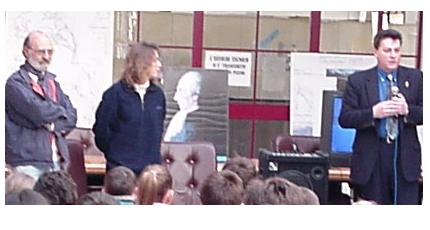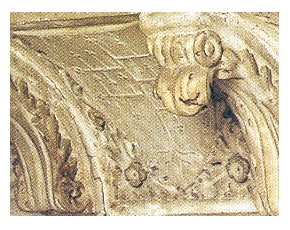
Mulazzo * Massa-Carrara * Italia
Newsletter of the Centro
Year 2, no. 6 May 2, 2001
Edited by
Dario Manfredi and Rossana Piccioli
Translated
by John Black
NEWS
¯ A solo navigator in the wake of the Malaspina Expedition

Roberto Malaspina, mayor of Mulazzo, Captain Laura Zolo and the director
of the
Centro
di Studi Malaspiniani explain the projected voyage of the boat Seven
Roses in the wake of the Malaspina Expedition.
Between 2002 and 2004, a number of sections of the itinerary of the corvettes Descubierta and Atrevida will be retraced by the solo navigator Laura Zolo in the sailboat Seven Roses (an 11.5 metre Charpentier-style steel sloop). Captain Laura Zolo (born 35 years ago on the island of Elba) is no newcomer to enterprises of this type, having already retraced the route followed by the Zeno brothers and completed other "historical" voyages.
The idea of following in the wake of the Malaspina Expedition is thoroughly novel, especially because it will involve completing not only a sporting but also a cultural enterprise. In relation to the latter aspect, in fact, the Centro di Studi Malaspiniani – which is sponsoring the project – intends to organize a series of events that will interest both schools in Lunigiana and the most important cultural institutions of the various areas visited. Through the use of slides and video, along with lectures, articles and other tools of communication, pupils in the schools of Lunigiana will be able to follow the progress of the trip while – on the other side of the ocean – the community of Italian emigrants can "rediscover" the experience of our great navigator of the 18th century. Cultural meetings may even be possible with the descendants of the First Nations populations encountered by Alexandro Malaspina. The project is currently in the elaboration phase, but we are already able to identify the three principal regions which the trip will involve:
In an earlier newsletter we announced the project of twinning of Mulazzo and other places in Lunigiana with Patagonian settlements that were visited by the Malaspina Expedition. An ad hoc study group is working actively on this project, and from Argentina we have received the following information:
Teachers at the Università Cattolica di Buenos Aires have contacted political, administrative and cultural figures in Puerto San Julián, Puerto Deseado, Rawson and San Carlos Bariloche for the purpose of furthering the twinning project between the Italian communities where the explorers of Patagonia were born and the Argentinian places visited by their expeditions.
Specifically, a clear interest has emerged in promoting a cultural and economic exchange between Puerto Deseado, Puerto San Julián and Mulazzo, whose mayor will be officially invited to Patagonia.
In Puerto Deseado, in particular, consideration is being given to setting up a museum devoted to the history of that settlement, where a suitable rôle will be allotted to the figure of Alexandro Malaspina.
There is special interest in the idea of organizing, both in Lunigiana and Patagonia, visits by students of history and political science.
Puerto Deseado has expressed its wish to obtain
a marble bust or bas-relief portraying Alexandro Malaspina, which would
be set up on its "Navigators' Walk." The Centro di Studi Malaspiniani
will try to fulfil this wish. It is beyond doubt that a figure of
the Italian Navigator would contribute to strengthening the traditional
bonds of friendship that already bind Argentina and Italy.
PUBLICATIONS RECEIVED
G. FRANCI – M. LALLAI, Da Luni a Massa Carrara – Pontremoli: il divenire di una Diocesi fra Toscana e Liguria dal IV al XXI secolo, Aedes Muratoriana, Modena, 2000, first part, vol. 3.
This imposing
work proposes to trace the history of the diocese of Luni, and it is clear
that the
names
of members of the Malaspina family appear frequently, either because they
were bishops of Luni, or because for decades they fought fiercely against
the bishops. The work is extremely well organized and, on account
of its wealth of bibliographical data and indexes, will surely become a
required point of reference for all historiographers of Lunigiana and its
adjoining territories. On Bishop Bernabò Malaspina, however,
see below: Pedant's Corner.
F. LEVA (ed.), Storia delle Campagne oceaniche della R. Marina, Ufficio Storico della Marina Militare, Rome, 1992, 4 vols.
This work gives an overview of all the maritime campaigns, voyages of circumnavigation and missions completed by the united Italian Navy from 1861 to 1959. Particular prominence is given to the voyages of the ships Magenta, Principessa Clotilde, Vettor Pisani, Garibaldi, Governolo, Vedetta, Vespucci, Colombo, Staffetta, Archimede, Europa, Dogali, Umbria, Puglia, Calabria, Elba, Bausan, Caracciolo, Liguria, Marco Polo, Fieramosca, Etruria, Etna, Cavour, Roma, Libia and others.
«IL POLO», Rivista trimestrale dell’Istituto Geografico Polare "Silvio Zavatti," Year 55 (2000), nos. 2-3.
In this edition of the magazine (which is intended to emphasize its own commitment to the defence of ethnic minorities) we draw your attention to:
In this monograph edition are
published the scientific accounts of the excavations carried out
in the important church of
Vezzano.
Luisa ROSSI (ed.), Dora d’Istria. I bagni di mare. Una principessa europea alla scoperta della Riviera, Sagep, Genova, 1998.
This volume reprints some writings
on Liguria and the Gulf of La Spezia by Dora d'Istria, nomme de plume
of Princess Helen Ghika, born in Bucharest in 1828, the first child of
Prince Michael, ruler of the principality of Walachia. A cultured
writer and tireless traveller, she published numerous works of an historical
and political character on the various countries in which she lived, essays
on the condition of women in the West and the East, travel accounts and
literary studies. The chapter on the Gulf of La Spezia, with vivid descriptions
inspired by the voyages pittoresques, was written in 1867 and was
first published in the illustrated magazine Le Tour du Monde in 1869.
PEDANT'S CORNER

Sarzana, church of San Francesco.
Tomb of Bishop Bernabò Malaspina (detail)
Quite a lot has been written about Bernabò Malaspina, Bishop
of Luni, and the interest in
this character is understandable: in Sarzana, in the church of San
Francesco, stands his funeral monument, which is surely one of the best
mediaeval sculptures preserved in Lunigiana. It is nevertheless sad
that certain errors continue to be repeated which, with a little good will,
could be eliminated. In a recent and otherwise rigorous book, for
example, it is once again repeated that Bernabò was the son of Corrado
Malaspina "l'Antico," and therefore belonged to the Spino secco [Dry Thorn]
branch of the family.
Now, even if one did not know the documentary study by Eliana M. Vecchi,
Per
la biografia del vescovo Bernabò Malaspina del Terziere (+1338),
Studi Lunigianesi, XXII-XXIX (1992-99), Villafranca Lunigiana, 1999, pp.
109-141, in which the matter is clarified, any
doubt could simply be eliminated by observing the funeral monument,
in which (see photo) appears the Spino fiorito [Flowering Thorn].
Is it possible that nobody ever noticed this?